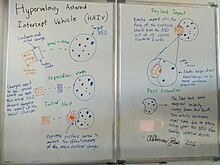| This is a Wikipedia user page. This is not an encyclopedia article or the talk page for an encyclopedia article. If you find this page on any site other than Wikipedia, you are viewing a mirror site. Be aware that the page may be outdated and that the user in whose space this page is located may have no personal affiliation with any site other than Wikipedia. The original page is located at https://en.wikipedia.org/wiki/User:DA5800T/sandbox/Hypervelocity_Asteroid_Intercept_Vehicle. |

A Hypervelocity Asteroid Intercept Vehicle (HAIV) is a spacecraft being developed by NASA to deflect dangerous Near Earth Objects (NEOs) such as comets and asteroids that threaten colliding with Earth.[1] HAIVs focus on utilizing powerful explosives, such as nuclear bombs, to achieve deflection by detonating on the surface of the NEO to change its trajectory away from Earth. This method of asteroid impact avoidance is intended to be used on dangerous NEOs detected within a short time frame (less than 5 years) before a possible impact event with Earth. The idea came about when asteroid detection became accurate and since then, scientists and engineers have come up with a well thought out design for an HAIV.
History
editBackground
editOver the years, certain events brought up the idea of planetary defense from NEOs. These events lead to the development of the HAIV that NASA intends to use.
Project Icarus
editIn 1967, Professor Paul Sandorff at the Massachusetts Institute of Technology asked his graduate students to come up with a plan to deflect the asteroid 1566 Icarus as it frequently passed by Earth. NASA at the time was concerned that 1566 Icarus could possible collide with the Earth after observing its close orbit. The students decided on using the contemporary Saturn V rocket along with a hypothetical 100-megaton nuclear bomb that Russia could develop, to provide enough force to deflect 1566 Icarus. It was estimated afterward that Project Icarus had 71% chance of being successful at protecting the Earth. Though it never was tested, it laid the foundation for the HAIVs being developed today.[2]
Chelyabinsk meteor
editIn 2013, a meteor about 30 meters in diameter and weighing about 13,000 metric-tons had an impact event over Russia. Once in Earth's lower atmosphere it burned up and then exploded.NASA expected the meteor to burn up without any issues, but was not the case.[3] This relatively small meteor damaged over 7200 buildings and injured over 1400 people.[4] The Chelyabinsk meteor brought renewed attention towards asteroid defense and the remains of the meteor gave scientists more data on asteroids.
Design
editsubdesign
editsubsubdesign
editAfter detecting many of the asteroids within our solar system and observing their composition through meteorite remains, NASA has identified multiple large asteroids that may collide with Earth. To combat these NEOs, NASA has come up with the following design for an HAIV. The vehicle is split into two major parts; the leader craft and the follower craft.[5]
Leader Craft
editThe leader craft is initially attached to the follower craft, but before impact the two crafts are spread out by an extendable pillar known as the AstroMast Boom. Furthermore, it contains the primary guidance systems including normal cameras and Lidar (light based radar). The purpose of this craft is to make an initial crater in the target NEO where the follower craft may detonate in. Doing this helps direct the explosive energy of the follower craft, hopefully applying enough force to change the orbit of the NEO.[5]
Follower Craft
editThe follower craft contains the following:
- Solar panels and batteries to power both the follower and leader craft.
- A large antenna and communication electronics to relay information back to Earth.
- A camera to check on the status of the leader craft.
- The NED (Nuclear Explosive Device) which detonate upon impact with the NEO.
- Thrusters and fuel tanks to help the vehicle to travel towards the target NEO.
- Other support systems and fail safes in the case of a malfunction.
Once the leader craft impacts the NEO and makes a crater, the follower craft detonates its NED soon after. It also relays back whether the detonation was a success or failure which can be confirmed by observation from the Earth.[5]
Obstacles
editThere are numerous factors that have slowed the development of the HAIV. These include but aren't limited to budget, law, and irregular NEOs.
Budget
editInitial test missions have cost between 600 million to 1.8 billion and these were to test the feasibility of the guidance. A full mission may cost much more than this amount, especially in the case of a NEO detected with a short time till collision with Earth. With recent cuts to NASA's funding, it is unsure whether an HAIV mission will ever occur.
Law
editThe United Nations Committee on the Peaceful Uses of Outer Space set a law that nuclear weaponry cannot be used in outer space. Known as the Partial Nuclear Test Ban Treaty (NTB), this law prohibits the HAIV NASA is designing to use a live NED.
Irregular NEOs
editSometimes NEOs are difficult to track. They could have an irregular orbit or be spinning, making it hard for the leader craft to make an initial crater. If the HAIV doesn't make proper contact, the NEO's orbit may not change and go on to collide with Earth. NASA is currently working out how to combat this problem.
References
edit- ^ Administrator, NASA. "An Innovative Solution to NASA's NEO Impact Threat Mitigation Grand Challenge and Flight Validation Mission Architecture Development". NASA. Retrieved 2016-01-29.
- ^ "MIT Saves the World: Project Icarus (1967)". WIRED. Retrieved 2016-02-13.
- ^ Jenner, Lynn. "Around the World in Four Days: NASA Tracks Chelyabinsk Meteor Plume". NASA. Retrieved 2016-02-13.
- ^ "Meteor 'Something We Only Saw in Movies'". ABC News. 2013-02-16. Retrieved 2016-02-02.
- ^ a b c Barbee, Brent W.; Wie, Bong; Steiner, Mark; Getzandanner, Kenneth (2013-08-19). "Conceptual Design of a Hypervelocity Asteroid Intercept Vehicle (HAIV) Flight Validation Mission". Boston, MA, United States.
{{cite journal}}: Cite journal requires|journal=(help)